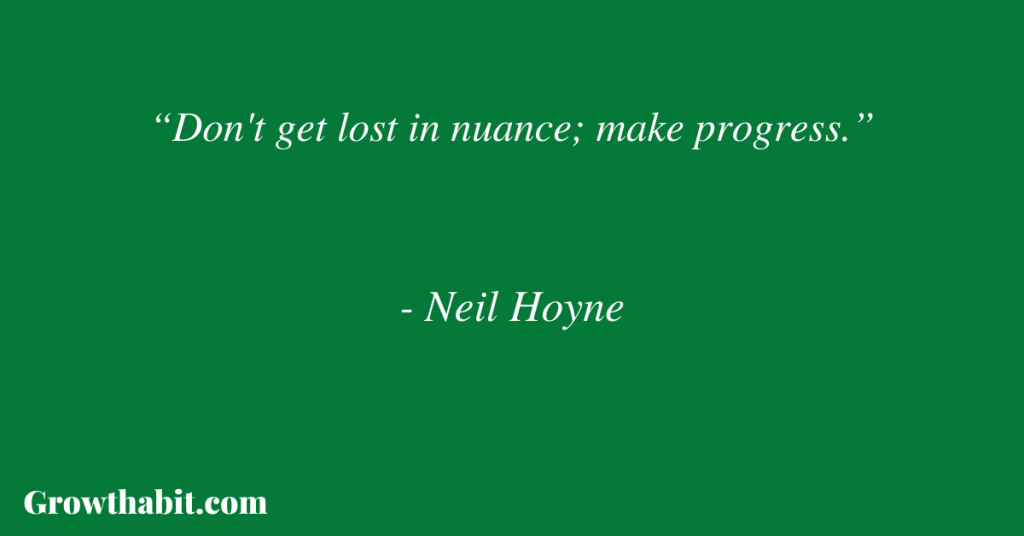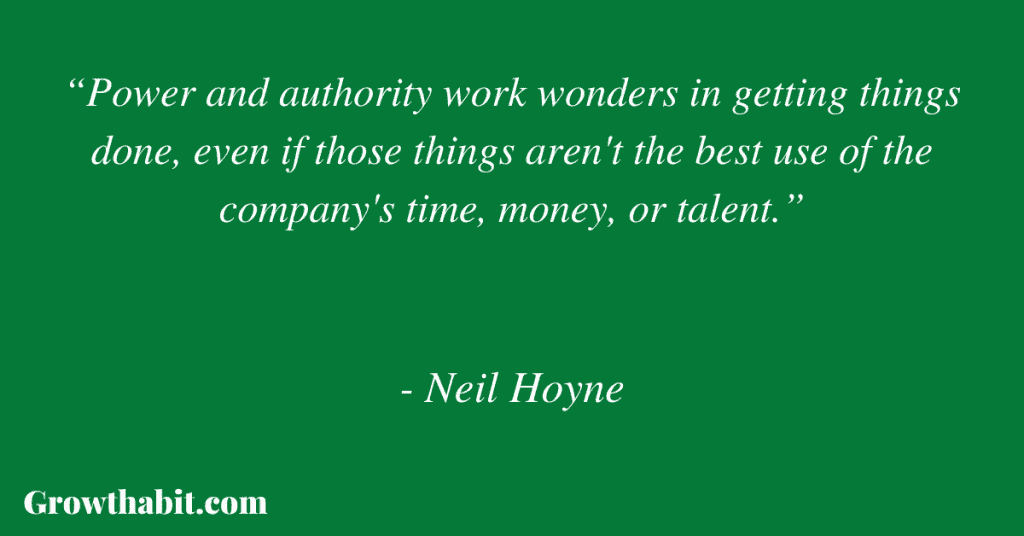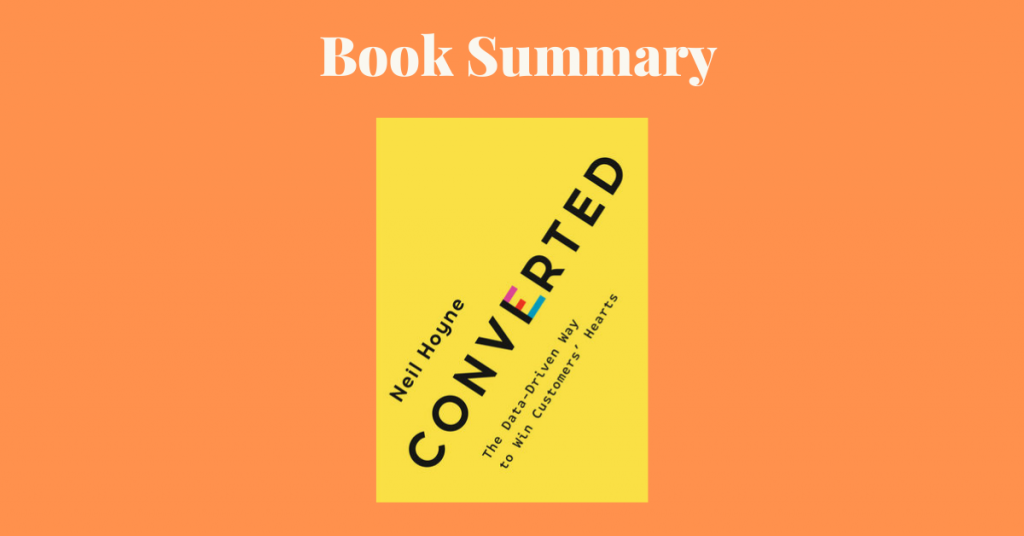Converted by Neil Hoyne is a book about the conversation that engages others, relationships that will help us identify the people that matter, and self-improvement that will help us build a culture of exploration and risk-taking.
Book Title: Converted: The Data-Driven Way to Win Customers’ Hearts
Author: Neil Hoyne
Date of Reading: March 2022
Rating: 8/10
What Is Being Said In Detail:
Converted has a three-part structure- Conversations, Relationships, and Self-Improvement- with a total of 19 chapters.
1. Let’s Talk
The first chapter talks about the importance of having a conversation with your potential customer before any exchange happens. You won’t simply go into a bar, look at the person and ask them to marry you this instant (yet this is what happens in digital marketing).
2. Starting Simple
The second chapter is all about starting simple. And to do that, you need to get moving with small teams and swift actions, start with people (money), and know their names (so you can connect them in different systems).
3. Ask Questions
The third chapter is about asking questions that will tell them more about customer’s goals, advance the conversation, and deepen their understanding of the situation. Targeted questions such as “Are you buying this as a gift?” or “What do you like most about us” will get you better data.
4. Embrace Human Nature
The fourth chapter talks about the human nature and how marketing isn’t an exact, objective science. So remember to tease the finish line by giving people a sense of progress, emphasizing scarcity and loss aversion, and applying some peer pressure in the form of recommendations.
5. Take a Hint
The fifth chapter is about understanding hints that happen during a conversation with the client. Read hints by starting with the problem, measuring outcomes, and leaving “the middle part” to already established machine learning models (don’t reinvent the wheel).
6. Guide the Conversation
The sixth chapter talks about participating in the conversation. It’s not only important to listen to your customers and offer your product, you need to guide them through their shopping experience.
7. Let’s Talk About Your Friends
The seventh chapter is a short one, describing how you need to need to segment your customers as you would people around you. Some are family, some are best friends, and others are simply associates. Treat them accordingly.
8. Knowing Where Things Stand
The eighth chapter starts by explainig CLV- customer lifetime value. CLV predicts how much a business will earn from a single relationship over lifetime. For CLV, it’s important to have enough of the right data, use the right model, and then compare the actual numbers with our model prediction numbers (called MAPE). If the numbers are more than 10% apart, it’s time to rework the model.
9. Meet Better People
The ninth chapter talks about finding the right people for your business. Maybe they won’t immediately spend a lot of money on your products, but focus on their CLV and move your marketing budget so that you acquire more of those people.
10. Accept People for Who They Are
The tenth chapter explains why we shouldn’t try to change our customers and make them into something they’re not (it’s expensive and can be the company’s downfall). The customer acquisition cost (CAC) needs to be lower than the customer lifetime value (CLV).
11. Make It Work or Say Goodbye
The eleventh chapter is about finding out small hints that your customers will leave and then retaining them. When they opt-out of your emails, it’s already too late. Figure out which ones are worth saving and invest more in retaining them.
12. Listen to the Right Voices
The twelfth chapter talks about the different opinions you will receive from your customers, but they all won’t have the same weight. Focus on the opinions, concerns, and feedback from the highest value customers.
13. Get Out There
The thirteenth chapter explains that your business isn’t only what it does today, but what it can do tomorrow.
14. Let’s Talk About You
The fourteenth chapter is a short one, preparing us on how to sell the insights we learned to people around us.
15. Take Small Steps Forward
The fifteenth chapter starts with a story from Washington, explaining how Congress banned representatives from going to dinner with lobbyists. Instead, they could only mingle when there’s food that’s on a toothpick (thus forming the “toothpick” rule). The chapter tells us that we need to progress by taking small actions forward (“toothpick” rule) instead of trying to find the perfect solution to the problem.
16. Try a Career in Politics
The sixteenth chapter opens up with statistics that only 6% of marketing decisions are based on data. The data alone isn’t enough- people have relationships, egos, and personalities that affect decisions and you need to learn how to read the room to start nudging people toward data-based decision-making.
17. Unleash the Testers
This chapter is about testing out new ideas as soon as possible and hastily implementing the insights you gain from them. Remove the unnecessary layers between testers and decision-makers and just run the tests. And when you do, implement them as soon as possible because the insights will change over time.
18. Be Faithful but Not Blind
The eighteenth chapter talks about how every metric can be corrupted. All teams and employees that will receive their salaries and bonuses if they hit certain metrics will ensure that they hit them (even if that will damage something else in the company). So make sure that anyone with “green numbers” can explain the process of how they got the numbers since that will ensure that the process is understandable and repeatable.
19. Field a Winning Team
The last chapter talks about the people who will be a problem in your team, such as perfectionists, efficiency experts, and insecure ones. And it also talks about the people who will benefit your team, such as storytellers, entrepreneurs, and students.
Most Important Keywords, Sentences, Quotes:
1. LET’S TALK
/
2. STARTING SIMPLE
/
3. ASK QUESTIONS
/
4. EMBRACE HUMAN NATURE
“Marketing, like dating, isn’t an objective affair.”
5. TAKE A HINT
“It’s like wearing an outfit one day that everyone loves. Wear it the next day, and the day after, and for the next few weeks, and the response will change. Tastes change too. Markets and competitors change. Insights are not eternal truths. Don’t ever stop asking questions, running tests, looking for signals. Use what you can for today, but invest in finding answers for tomorrow.”
6. GUIDE THE CONVERSATION
/
7. LET’S TALK ABOUT YOUR FRIENDS
“Generally speaking, you’re going to get 80 percent of the value—in life or in business—from 20 percent of those you know. They are going to define your business and your profitability.“
8. KNOWING WHERE THINGS STAND
“The CLV column is what we’re really focused on: how much value they’ll bring to your business. That’s the opportunity. It’s calculated by multiplying the number of predicted future transactions for the customer by the average value per future transaction. The probability of future transactions is exactly what it sounds like. How likely is this customer to transact with us again?”
9. MEET BETTER PEOPLE
“And he found a signal: something that high-net-worth, high-disposable-income individuals in the United States tend to buy more often than people on the opposite end of the spectrum. Books.”
“As a marketer, there are three ways to build your business. You can meet new people (acquisition). You can improve the relationships you have (development). Or you can work to save relationships that may be on the way out (retention).”
10. ACCEPT PEOPLE FOR WHO THEY ARE
“With ample money in the bank and the goodwill of the board, they surged forward with a turnaround and committed the real sin of CLV: they tried to turn low-value customers into top spenders, lead into gold.”

“Restaurants, bakeries, and yoga classes drew hordes of customers for $5 each, eating the cost with hopes of turning them into highvalue customers later. Most never came back. They were interested in the deal, not the relationship. It’s the wrong way for any company to think of its customers.”
11. MAKE IT WORK OR SAY GOODBYE
/
12. LISTEN TO THE RIGHT VOICES
“Imagine you ran a survey and found that 87 percent of respondents said the most important thing about air travel is low fares.[*] The other 13 percent valued seat comfort and service. Every answer being equal, you’d build your marketing around low fares. But what if you also knew that 87 percent flew only once each year? And that the 13 percent, your frequent fliers, generated 50 percent of your revenue?”
13. GET OUT THERE
/
14. LET’S TALK ABOUT YOU
/
15. TAKE SMALL STEPS FORWARD
“Don’t get lost in nuance; make progress.”
16. TRY A CAREER IN POLITICS
“We know that only 6 percent of marketing decisions are based on data.[*] About 50 percent are made based on personal experience, judgment, and intuition—a figure, interestingly enough, that doesn’t vary whether you ask senior decision makers or junior decision makers. About 10 percent are made because of what the boss says, and another 10 percent because of what colleagues say.”
17. UNLEASH THE TESTERS
“An analyst brings ten ideas to her boss, who says, “Hey, I can’t pitch ten ideas to my CMO. Let’s pick one.” And that CMO is going to have five teams, and each gives him its top idea. Now he has five, but he can’t fund five, so he picks the one that sounds like a sure thing. And all of the analysts shrug their shoulders and proclaim, “I wish my company were data driven.”
“Power and authority work wonders in getting things done, even if those things aren’t the best use of the company’s time, money, or talent.”
18. BE FAITHFUL BUT NOT BLIND
“Metrics matter—and good metrics can make all the difference in helping you identify your best customers and find more like them. We’ve covered that. But here’s another simple truth: any metric can be manipulated with the right incentive. And it will be.”

“The methods matter as much as the metrics, and leaders won’t accept the metrics if they aren’t understandable or repeatable.”
19. FIELD A WINNING TEAM
“You want efficiency, but not efficiency experts. Let them run supply chains or call centers. And make sure 10 percent of your marketing budget is always tucked aside for exploration. Put it outside the efficiency scope. Measure the results not by the dollars that come back but by what you learn. It’s the key to driving your business forward.”
“Imperfect decisions driven by a business imperative to act are acceptable to this group. Haphazard choices to satisfy arbitrary deadlines or egos are not.”
Book Review (Personal Opinion):
Hoyne worked in Google and many of his insights are superb (and backed up by data). He explained everything there’s to know about winning over customers with a data-driven approach in mind.
Rating: 8/10
This Book Is For (Recommend):
- A CMO looking to improve their marketing numbers
- An entrepreneur who wants to understand customer acquisition
- Anyone who wants to learn how to impact people at their work
If You Want To Learn More
Here’s Neil Hoyne having a Google talk:
Google Talk
How I’ve Implemented The Ideas From The Book
We are right now experimenting with customer acquisition at Growthabit and the book really helped me pay attention to the metrics that matter (CAC and CLV foremost).
One Small Actionable Step You Can Do
Start measuring CLV in your company/blog and treat your highest value customers in the best possible way.

